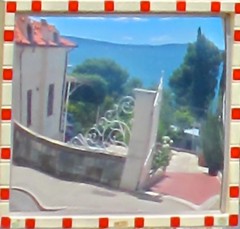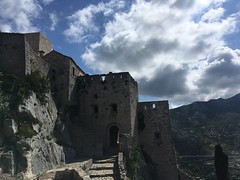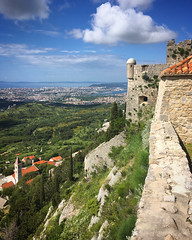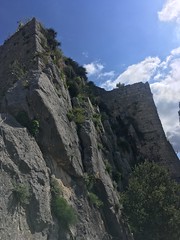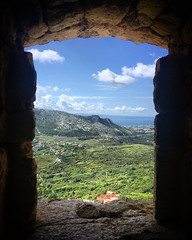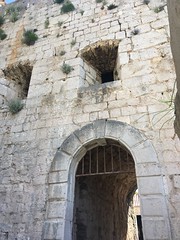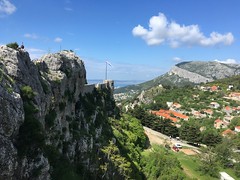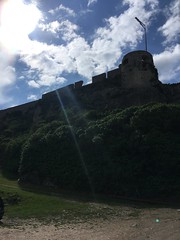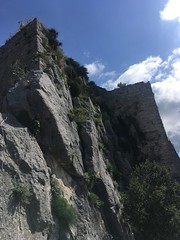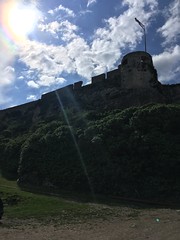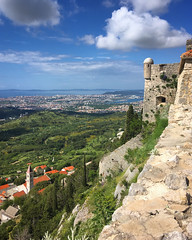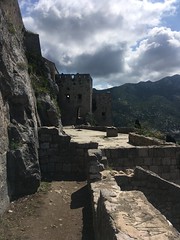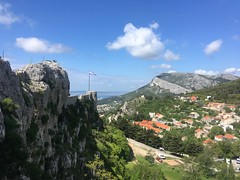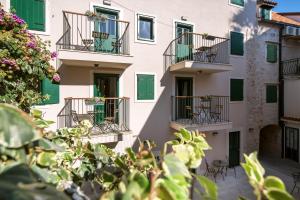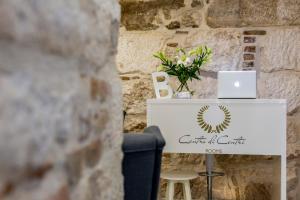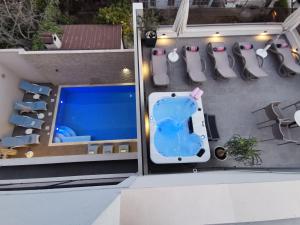Split
Split (English: /ˈsplɪt/; Serbo-croatian: [splît]; historically known as Spalato (from Venetian and Italian: Italian: [ˈspalato]); see other names) is the second-largest city of Croatia, the largest city in Dalmatia and the largest city on the Croatian coast. It lies on the eastern shore of the Adriatic Sea and is spread over a central peninsula and its surroundings. An intraregional transport hub and popular tourist destination, the city is linked to the Adriatic islands and the Apennine Peninsula.
The city was founded as the Greek colony of Aspálathos in the 3rd or 2nd century BC on the coast of the Illyrian , and in 305 AD, it became the site of the Palace of the Roman emperor Diocletian. It became a prominent settlement around 650 when it succeeded the ancient capital of the Roman province of Dalmatia, Salona. After the sack of Salona by the Avars and Slavs, the fortified Palace of Diocletian was settled by Roman refugees. Split became a Byzantine city. Later it drifted into the sphere of the Republic of Venice and the Kingdom of Croatia, with the Byzantines retaining nominal suzerainty. For much of the High and Late Middle Ages, Split enjoyed autonomy as a free city of the Dalmatian city-states, caught in the middle of a struggle between Venice and Croatia for control over the Dalmatian cities.
Venice eventually prevailed and during the early modern period Split remained a Venetian city, a heavily fortified outpost surrounded by Ottoman territory. Its hinterland was won from the Ottomans in the Morean War of 1699, and in 1797, as Venice fell to Napoleon, the Treaty of Campo Formio rendered the city to the Habsburg monarchy. In 1805, the Peace of Pressburg added it to the Napoleonic Kingdom of Italy and in 1806 it was included in the French Empire, becoming part of the Illyrian Provinces in 1809. After being occupied in 1813, it was eventually granted to the Austrian Empire following the Congress of Vienna, where the city remained a part of the Austrian Kingdom of Dalmatia until the fall of Austria-Hungary in 1918 and the formation of Yugoslavia. In World War II, the city was annexed by Italy, then liberated by the Partisans after the Italian capitulation in 1943. It was then re-occupied by Germany, which granted it to its puppet Independent State of Croatia. The city was liberated again by the Partisans in 1944, and was included in the post-war Socialist Yugoslavia, as part of its republic of Croatia. In 1991, Croatia seceded from Yugoslavia amid the Croatian War of Independence.
Name
The name Aspálathos or Spálathos may come from the spiny broom (Calicotome spinosa, ασπάλαθος in Greek), although it is the related Spanish broom (Spartium junceum, σπάρτος) that is common in the area.
In Latin, the name became Spalatum or Aspalatum, which in the Middle Ages evolved into Aspalathum, Spalathum, Spalatrum, and Spalatro in the Dalmatian language of the city's Romance population. The Croatian term became Split or Spljet, while the Italian-language version, Spalato, became universal in international usage by the Early Modern Period. In the late 19th century, the Croatian name increasingly came to prominence, and officially replaced Spalato in the Kingdom of Yugoslavia after World War I.
Formerly, the name was thought to be related to Latin palatium 'palace', a reference to Diocletian's Palace. Various theories were developed, such as the notion that the name derives from S. Palatium, an abbreviation of Salonae Palatium. The erroneous "palace" etymologies were notably due to Byzantine Emperor Constantine VII Porphyrogenitus, and were later mentioned by Thomas the Archdeacon. The city, however, is several centuries older than the palace.
History
Antiquity
Although the beginnings of Split are traditionally associated with the construction of Diocletian's Palace in 305, the city was founded several centuries earlier as the Greek colony of Aspálathos, or Spálathos. It was a colony of the polis of Issa, the modern-day town of Vis, itself a colony of the Sicilian city of Syracuse. The exact year the city was founded is not known, but it is estimated to have been in the 3rd or 2nd century BC.
The Greek settlement lived off trade with the surrounding Illyrian tribes, mostly the Delmatae.
After the Illyrian Wars of 229 and 219 BC, the city of Salona, only a short distance from Spálathos, became the capital of the Roman Province of Dalmatia and one of the largest cities of the late empire with 60,000 people. The history of Spálathos becomes obscure for a while at this point, being overshadowed by that of nearby Salona, to which it would later become successor. The Roman Emperor Diocletian (ruled AD 284 to 305) in 293 began the construction of an opulent and heavily fortified palace fronting the sea, near his home town of Salona, selecting the site of Spálathos (or Spalatum in Latin).
The Palace was built as a massive structure, much like a Roman military fortress. The palace and the city of Spalatum which formed its surroundings were at times inhabited by a population as large as 8,000 to 10,000 people.
Between 475 and 480 the Palace hosted Flavius Julius Nepos, the last recognised Emperor of the Western Roman Empire. Salona was lost to the Ostrogothic Kingdom in 493, along with most of Dalmatia, but the Emperor Justinian I regained Dalmatia in 535–536.
Middle Ages
The Pannonian Avars sacked and destroyed Salona in 639; the surviving Romans fled to the nearby islands. The Dalmatian region and its shores were at this time settled by tribes of Croats, a South Slavic people subservient to the Avar khagans. The Salonitans regained the land under Severus the Great in 650 and settled the 300-year-old Palace of Diocletian, which could not be effectively besieged by the Slavic tribes of the mainland. The Emperor Constans II granted them an Imperial mandate to establish themselves in the Palace as the City of Spalatum, which imposed upon the Croatian Slavs - at the time alied of Byzantium against the Avars - a cessation of hostilities. The Temple of Jupiter was rededicated to the Virgin Mary and the remains of the popular Saint Domnius were recovered from the ruins of Salona, later establishing the Cathedral of Saint Domnius as new seat of the Archbishop of Salona.
Until the Sack of Constantinople, Split remained a de jure possession of the Byzantine Empire as a Byzantine duchy, administered by the Exarchate of Ravenna and after 751 by Jadera (Zadar). Its hinterland, however, was now home to the Duchy of the Croats. In this period, an independent Dalmatian language developed from Latin, with a distinct local dialect: to its inhabitants, the city became known as Spalatrum or Spalatro, one of the main Dalmatian city-states.
In 925 Tomislav's Kingdom of Croatia emerged in the hinterland of the city, centered in Nin as an ally of Byzantium against Simeon I of Bulgaria - though without receiving any power from the Emperor over the Dalmatian cities. The rise of the rival Bishopric of Nin, headed by Bishop Gregory, which attempted to institute the "Slavonic" or "Slavic language" as the language of religious service, led to the 925 Synod of Split, at which it was decreed that "no one should presume to celebrate the divine mysteries in the Slavonic language, but only in Latin and Greek, and that no one of that tongue should be advanced to the holy orders".
In 1100, the bell tower which became the main symbol of the city was constructed and dedicated to Saint Domnius, by then regarded as the patron saint of the city.
Throughout the 9th and 10th centuries, Split was raided by the Narentines (a South Slavic confederation recognizing the King of Croatia as their sovereign). Therefore, the city offered its allegiance to Venice and in 998 the Venetian Doge Pietro II Orseolo, led a large naval expedition which defeated the Narentines the same year. After obtaining permission from Emperor Basil II in Constantinople, Orseolo proclaimed himself Duke of Dalmatia. In 1019 the Byzantine Empire restored direct control over Dalmatia. The title "Duke of Dalmatia" seems to have been dropped at this point by the Venetian doges. In 1069 Peter Krešimir IV, King of Croatia, gained control over Dalmatian islands and cities, including Split, and stretched his rule south to Neretva. The coastal cities retained autonomous administration and were still nominally under Byzantine Empire, but were now subjects of the Croatian king.
After the death of Croatian King Stephen II in 1091, a period of succession crisis followed in Croatia, with King Ladislaus I of Hungary interfering in it. Byzantine Emperor Alexius took advantage of this and joined the old Theme of Dalmatia to the Empire. In 1096 Emperor Alexius, at the time engaged in the First Crusade, granted the administration of Dalmatia to the Doge of Venice.
In 1105 Coloman, King of Hungary, having conquered the Kingdom of Croatia, reneged on its alliance with Venice and moved on the coastal towns, besieging and taking Zadar. Split and Trogir decided then to surrender upon guarantee of their ancient privileges. The rights granted to the city (and reaffirmed by new charters) were substantial. Split was to pay no tribute, it was to choose its own count and archbishop whom the king would confirm, it preserved its old Roman laws, and appointed its own judge. Dues from trade (which were substantial in the period), were divided between the count, the archbishop, and the king, and no foreigner was to live within the walls of the city against the will of the citizens. These rights were generally upheld by Hungarian kings, but there were inevitable incidents of violation.
After Coloman's death in 1116, the Doge Ordelafo Faliero returned from Outremer and retook all the Dalmatian cities, and also, for the first time, the Croatian cities of coast such as Biograd and Šibenik. In 1117, however, he was defeated and killed in renewed battle with the Hungarians under Stephen II of Hungary, and Split again acknowledged Hungarian rule. But the new D…



